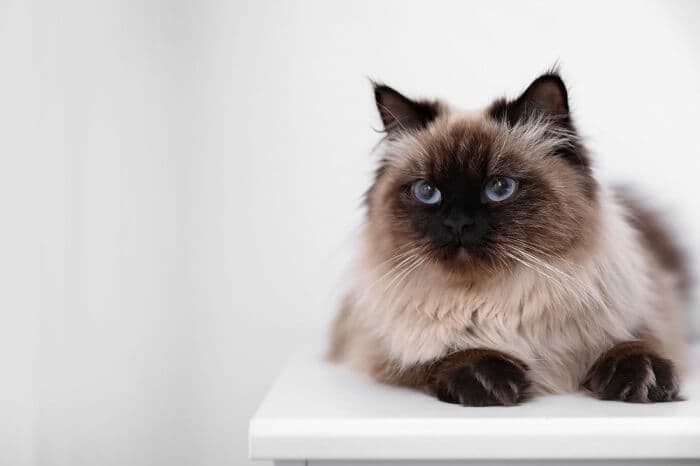
balinese
Affectionate, inquisitive, outgoing, intelligent
Overview
Origin
United States
Life Span
12-15 years
Height
8"-10"
Weight
4-10 pounds
Group
Small to medium-sized longhair
Price
$1,000 - $1,500
History

The history of the Balinese cat is a long one, beginning in the mid-1800s, when the first Siamese cats were imported to the U.S. and the UK from Thailand. Breeders soon noticed that purebred Siamese cat litters sometimes contained longhaired kittens.
At first, these kitties were sold as pets only. In 1928, the American Cat Fanciers’ Federation allowed registration as “Long-haired Siamese” and by the 1950s, breeders were selecting for the long-haired genetic trait.
We have one of the first Balinese cat breeders to thank for giving the breed its name: Helen Smith felt that the term “long-haired Siamese” was too cumbersome. She named the breed after Balinese dancers, known for their beauty and grace.
The Balinese cat breed was further refined through the 1960s and 1970s. Another breeder named Sylvia Holland selected strictly for cats that showed traditional Siamese points in chocolate, seal, lilac, and blue.
At the same time, CFA had begun to allow red, cream, lynx, and tortie point Siamese cats under the moniker “Colorpoint Shorthair.” Further development of the Balinese cat led to the name “Javanese” for those showing colors consistent with colorpoint shorthairs.
The history of the Balinese cat – and the Javanese, too – came full circle during when CFA merged the two breeds.
In 2008, the Javanese cat was officially considered a Balinese color division. CFA went on to adopt a single standard for Balinese and Javanese cats in 2010, recognizing over 20 colors but judging them by Balinese and Javanese divisions.
Most registries have joined in, considering the Javanese to be a type of Balinese rather than a breed of its own, but some breeders and clubs continue to recognize the distinction between the two.
Care

Nutrition
While Balinese cats do not require a special diet, they do benefit from high-quality food with real meat or fish as the first ingredient. Natural diets are beneficial to all felines, and this breed is no exception!
Grooming
Balinese cats have a long-haired coat, but it’s a single coat rather than a double coat. The absence of a thick, fluffy undercoat practically eliminates the risk of matting, however you can help your cat look and feel fantastic by brushing and combing them a few times per week.
Exercise
Balinese cats need plenty of exercise and most are more than willing to seek playtime on their own. Give your cat plenty of toys to encourage play, and be sure that they have somewhere to perch and climb. A cat tree with different levels will help keep your Balinese happy while sparing your furniture.
Health
Balinese cats tend to be very healthy, and are capable of living to age 15 or even longer. Like their Siamese cousins, Balinese cats do have the potential to develop certain health issues including chronic bronchial disease and bladder stones. Some are born with crossed eyes or kinked tails.
Breed Standard

Body
Long, lean, and graceful, the Balinese has a medium-sized body with fine bones and lithe musculature. The body should have a tubular shape, with hips and shoulders of the same width.
Head
The Balinese cat has a long, tapering, wedge-shaped head. The wedge should begin at the nose and flare in straight lines that lead all the way to the tips of the ears, forming a distinct triangle shape without a break at the whiskers. The nose should be long and straight.
Eyes
Balinese cats are famous for their sapphire-blue eyes. The eyes should be fairly close together; there should be no more than a single eye’s width between them.
Ears
Balinese cats have large pointed ears with wide bases and distinctly pointed tips.
Color
There are four official Balinese cat colors: Seal point, chocolate point, lilac point, and blue point. The Javanese color division includes several other colors ranging from cream point.
Coat
The coat should be of medium length, with long, plume-like feathering on the tail. Balinese cats have single coats without downy undercoats. The feel is silky and soft, and the hair lies close to the body.
Tail
A Balinese cat’s tail should be long and thin, and should taper to a fine point. The tail hair should spread out like a plume.
Legs & Paws
The legs should be long and slender, with the hind legs higher than the forelegs. The paws should be oval-shaped, with a small, dainty appearance.